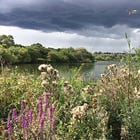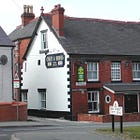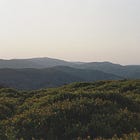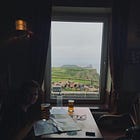Cwlwm: a knotty retrospective
One year on from our launch, we look back at the articles we've published, and the ties that bind them together.
Dear friends
It was just after Christmas last year that Cwlwm took its first tentative step into the world of e-newsletters, with an opening editorial that outlined briefly the kind of publication we hoped to become:
Cwlwm will collect and curate personal essays, fragments of experience hint at the whole. We will explore and uncover lesser known places and platform lesser heard voices. We will publish analysis of current events but look beyond the demands of the news cycle, and review with a critical eye Wales’ cultural production. Here our diverse communities will meet and mix and mingle; merge, collide and intersect. We will examine our differences and what makes each part of our country unique in order to identify the ties that bind us. Our focus will always be people.
A year later, we enter our denouement – a moment of untangling, if you will – as we prepare, at least for now, for a period of hiatus.
So where does one start? First, with you: all 800 of you. You’ve read 78 of our articles, between you, over 70,000 times. To every one of you who has enjoyed, commented on, shared, or connected with the writing we have published over the last year: diolch yn fawr. To our writers and contributors, especially those who didn’t think they were writers before: diolch o galon.
There has been so much excellent writing in Cwlwm over the last year that we thought it made sense to bring as much of it together as is sensible in a single newsletter. Despite its incredible diversity, there have been some themes. We’ve tried to sum these up as best as we can below and in doing so, we hope that you’re able to revisit some of your favourites, or catch up on pieces that were published before you subscribed.
Writing of now
Wales is alive with stories – that is why we started Cwlwm. We kicked things off in 2024 with James Bessant Davies’ coverage of Brecon’s Christmas celebrations and continued, across the year, to engage with events happening across Wales. By this we didn’t just mean the comings and goings of politics in Cardiff Bay (although there was plenty) or the big cultural set pieces, but the things happening all over and at all scales. It was a pleasure to feature M. Yesekaon’s piece about setting up a hip-hop studio in Colwyn Bay and the community that surrounds it. At the height of summer, Kit Habianic took us up abandoned spoil tips to learn about nature conservation efforts in these unique ecosystems. And in one of the most discussed pieces of the year, Tim Price made a passionate case for better arts funding with an argument that has one again become timely.
Writing the past
We come to know the present through the past; Wales is a nation steeped in (some would say smothered by) history. So many of our writers have written movingly and persuasively about coming to know more about their own Wales in the present through another one in the past. Sara Wheeler took us through her family’s history in Rhosllannerchrugog, marking the decline of traditional industry – but also the other forces that give the village life. Our most-read piece of 2024 was Roger Reese’s account of the history of the railway in Talyllyn, Powys and the recent community efforts to remember it in the world’s smallest railway museum. We both contributed pieces on connectivity and transport: Dylan writing about the phonebox in his home village of Pennorth and Merlin about the charm of charmless places, and walking on abandoned railway lines. In the heart of the capital, Emmet Moore chronicled a changing city through the fate of the Capitol theatre and subsequent shopping centre.
Untangling
We major on the metaphor at Cwlwm, and our favourite one is the knottiness of Wales and writing’s place as the celebrator, but also untangler, of the muddle that is our nation. Merlin wrote in our early days about his own milltir sgwâr on the Welsh border, and how a wider vocabulary of border words can unlock a greater understanding of this overlooked part of the country. John Briggs, more recently, has teased out a life lived in the local in his photographical retrospective of Newport’s pubs. Sometimes, what we are trying to untangle is ourselves: Polly Grace wrote movingly about growing up, place and family and her own lifelong relationship with the idea of Wales. On the other side of the continent, Silvia Rose immersed herself in Serbian hospitality and found herself thinking sometimes of home in Eryri. And on its twenty-fifth anniversary, Dylan pulled together the lost history of one of Wales’ most famous photographs, as we published it in colour for the first time.
Journeys
The best stories are tall tales of a long journey, and you can sometimes be surprised by what you find out along the way. Rhys Underdown took us with him around the Gower peninsula, recounting a trip made a few years ago with a good friend. Merlin visited Severnside to find out about a land that straddles a wild, wide river. And we joined Richard Huw Morgan for his sideways take on the National Eisteddfod in Pontypridd, via bridges, stone walls, and solar farms. Finally, Jasmine Donahaye took us to Cumbria in search of Rheged, lost in the maze of archival material.
All about people
In the summer, we wrote that Wales is all that we are: everything that we are makes up Wales. Cwlwm, first and foremost, is a celebration of all the people of Wales and all that we do, but we do this in our specificity, not in the broad brushstrokes of national pride. First, Tina Rogers took us into the heart of ‘quirky Chirky’ with its misfits and cowboys. A refugee from Turkey gave us a vital, first-person insight into life as an asylum seeker in Wales, living in a hotel room. Hedydd Ioan considered the energy of y werin (folk), and the relationship between folk and rap in Wales. Claire Boot explored the religious and social history of Penrhys, a community situated at a holy site high up in the Valleys. And Faisal Ali talked to players in the Butetown football scene about the game, the place, and Wales.
It’s a veritable smorgasbord of content this week, more than enough to keep you going on these dark and cold winter weekends. Please dive in and enjoy some of these ‘back stories’ and share them with your friends, either directly or via social media.
We’ve got a few more pieces in the pipeline to take us through the rest of January, so keep your eyes on your inbox over the next three Saturdays.
And if you’ve got an idea for your own Cwlwm story, don’t hesitate to get in touch. Reply to this email or contact merlin@cwlwm.org and/or dylan@cwlwm.org to float your idea. We’re not able to pay for stories at present, but can help you reach 800 readers right across Wales and beyond.

























